Modified starch is a familiar ingredient in food processing technology, but not everyone understands it and how to use it in food. In the following article, we will answer questions about modified starch and its applications in the food industry through the following article.
1 What is modified starch?
Modified starch is a type of starch that has the ability to enhance or adjust specific properties such as viscosity, substitution, adhesion, gelatinization temperature, etc. different from natural starch. They are produced through physical and chemical modification methods.
Currently, there are many different types of modified starch on the market to meet the needs of consumers. Some popular types include:
- Acetylated Starch E1420.
- Phosphated Starch E1412.
- Acetylated Distarch Adipate E1422.
- Acetylated Distarch Phosphate E1414.
- Oxidized Starch E1404.
 What is modified starch?
What is modified starch?
2 Benefits of modified starch in food
Modified starch has a wide range of applications in food processing technology thanks to the following superior features:
- Maintaining homogeneity: Modified starch helps food products maintain uniformity over a fixed period of time.
- Prolonging flavor: It helps food products maintain their delicious taste for longer periods of time.
- Controlling alkalinity and acidity: Modified starch has the ability to adjust the alkalinity and acidity of food, creating ideal conditions for better taste or expansion in certain products.
- Replacing gluten: Modified starch is often used as a substitute for gluten in food, meeting the needs of people with digestive problems.
- Cold-water soluble: In particular, this type of starch has the ability to dissolve in cold water or ready-to-eat foods, increasing convenience in use.
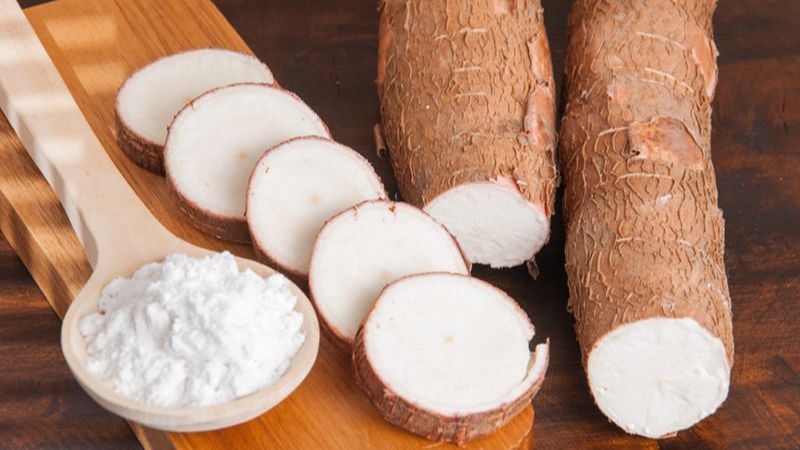 Benefits of modified starch in food
Benefits of modified starch in food
3 Applications of modified starch in food
Applications of Acetylated Starch E1420
Acetylated Starch E1420 is created through the reaction between starch and acetic anhydride or vinyl acetate, creating a unique type of starch with certain properties:
- It prevents the loss of thickening ability, thickening, and water leakage.
- It improves stability during the thickening process.
- It enhances the water-holding capacity of food.
- It reduces the gelatinization temperature of starch.
- It enhances viscosity and transparency, improving product surface.
This modified starch is commonly used in various industries including , , , frozen instant food, , , , and seafood.
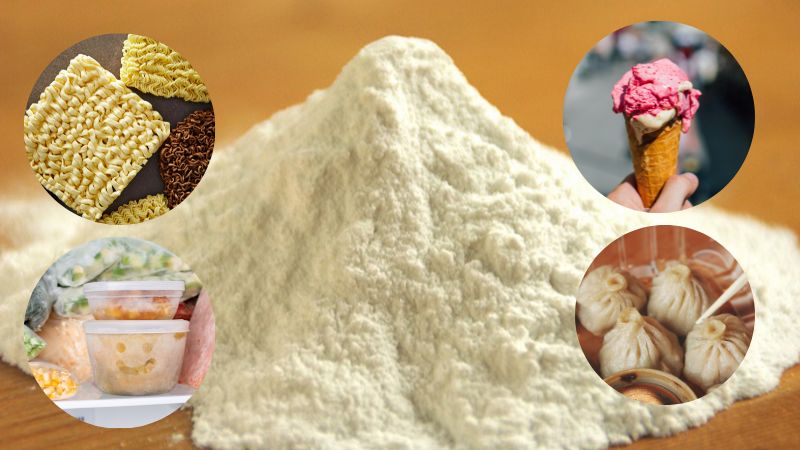 Applications of Acetylated Starch E1420
Applications of Acetylated Starch E1420
Applications of Phosphated Starch E1412
Phosphated Starch E1412 is created by enhancing cross-linking within the starch molecule structure. This provides the following special properties:
- It enhances crunchy texture for products such as , , (replacing fat).
- It thickens products during the processing of , noodles, vermicelli, and noodle products.
- It serves as a stabilizing agent to thicken flexible food.
- It increases the strength of soft powders, making them more elastic and less likely to break when cooked for a long time, exposed to acid, or under intense agitation.
This modified starch has many applications, including in the production of , , , , sausage, fish balls, fish cakes, and many other food products.
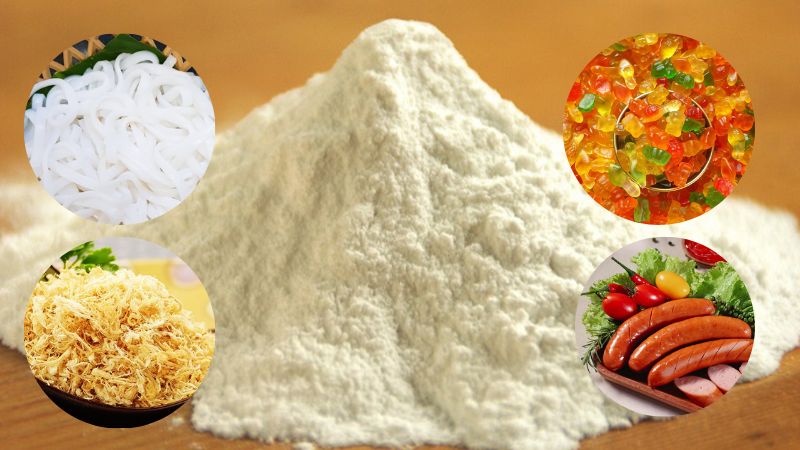 Applications of Phosphated Starch E1412
Applications of Phosphated Starch E1412
Applications of Acetylated Distarch Adipate E1422
Acetylated Distarch Adipate E1422 is created through the treatment of starch with adipic anhydride and acetic anhydride, resulting in a white or granular powder (if pregelatinized). This type of starch offers many excellent characteristics, combining the properties of Acetylated starch and cross-linked starch. Key features include:
- This modified starch shows stability at high temperatures and resistance to acidic environments.
- It retains water and stabilizes products for extended periods, while reducing the risk of water leakage in frozen products.
- It prevents structure retrogradation over time and minimizes syneresis in gels.
- Most importantly, this type of starch improves the surface of products and increases viscosity.
Acetylated Distarch Adipate E1422 has a wide range of applications, including in the production of , , , , , , various and , and many other canned products.
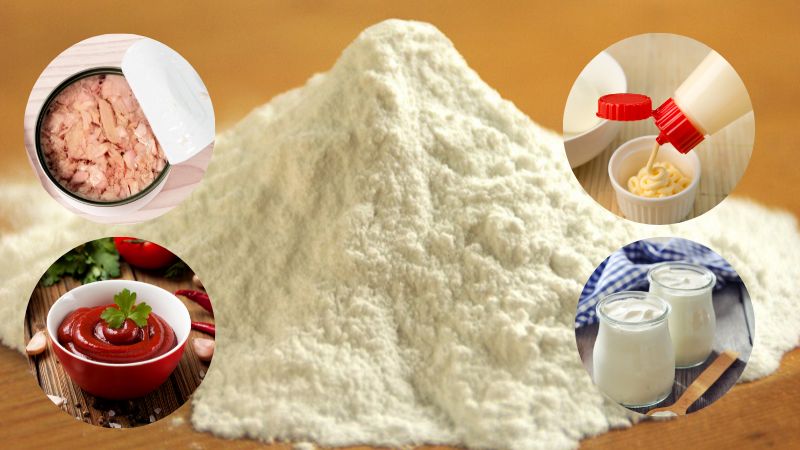 Applications of Acetylated Distarch Adipate E1422
Applications of Acetylated Distarch Adipate E1422
Applications of Acetylated Distarch Phosphate E1414
Acetylated Distarch Phosphate E1414 is created through the treatment of starch with Phosphorus oxychloride and Vinyl acetate, allowing it to combine the advantages of Acetylated starch and Phosphate starch (cross-linked starch). The key characteristics are:
- This modified starch is considered a stabilizer, helping to maintain the even dispersion of components in food.
- It also has emulsifying properties, helping to blend easily separated substances, such as oil and water.
- Acetylated Distarch Phosphate E1414 is a thickening agent, increasing the viscosity and consistency of food products.
- Its main application is in the canned and frozen food manufacturing industry, especially in the production of chili sauce, tomato sauce, black bean sauce, various sauces, meatballs, fish balls, and many other food products.
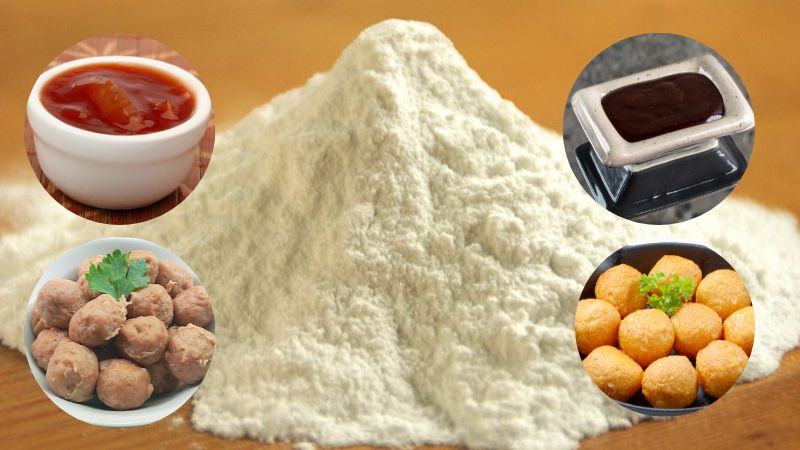 Applications of Acetylated Distarch Phosphate E1414
Applications of Acetylated Distarch Phosphate E1414
Applications of Oxidized Starch E1404
“Oxidized Starch E1404 is created through processing with various oxidizing agents to form oxidized starch. Under the influence of oxidizing agents, starch molecule’s glucoside bonds break, causing the starch granule’s structure to be disrupted and having shorter links compared to regular starch. Important characteristics include:
- It improves whiteness and reduces microbial content, creating a good film.
- It reduces water absorption and prevents oxidation, reducing degradation during production.
- It creates a shiny surface for products.
- Oxidized Starch E1404 has a wide range of applications in the food processing industry, especially in the production of cakes, gummy candies, canned sauces. In addition, Oxidized Starch E1404 is also widely used in the paper and textile industries.
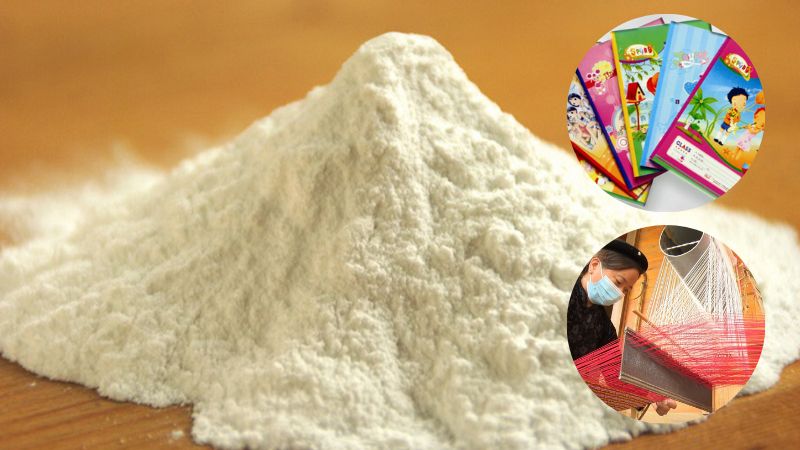 Applications of Oxidized Starch E1404
Applications of Oxidized Starch E1404
The above is information about modified starch, a type of food with many important applications that we have learned and collected. We hope the above article provides useful information for you.































